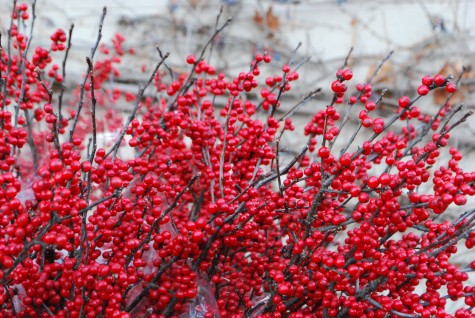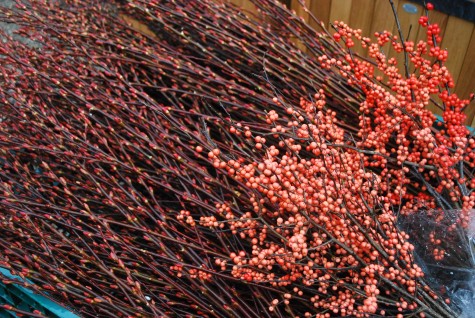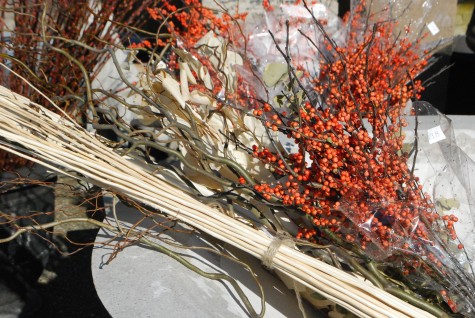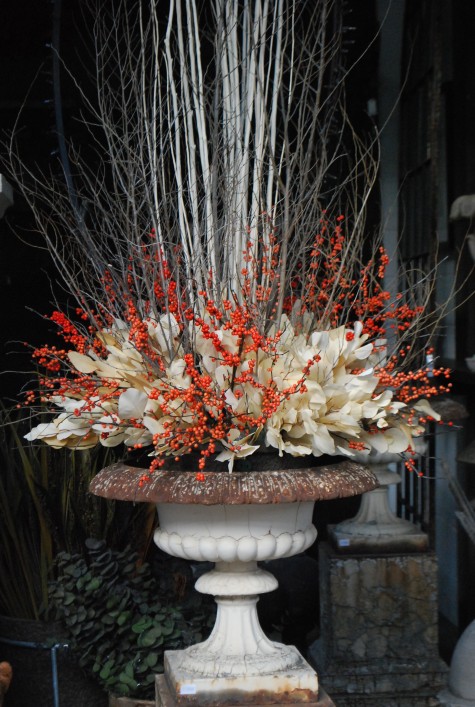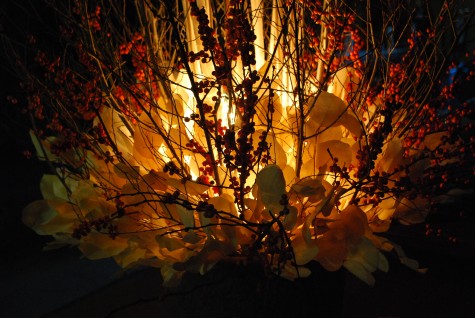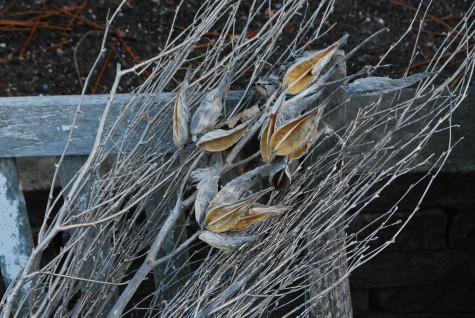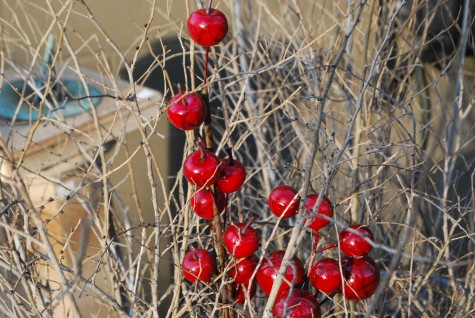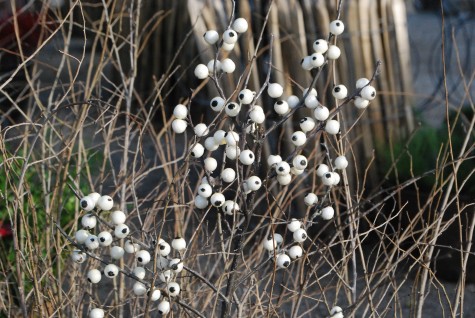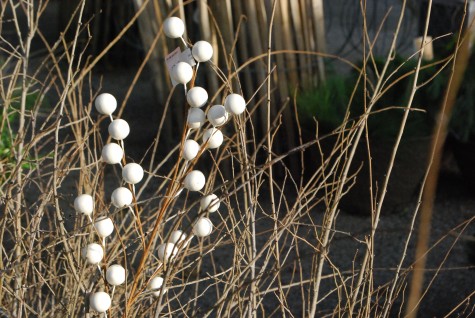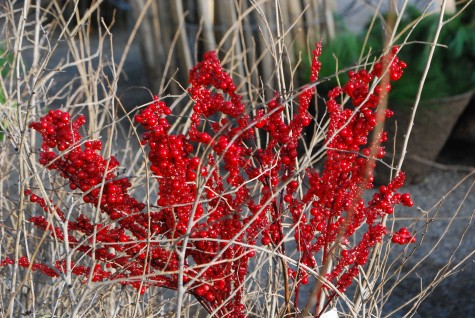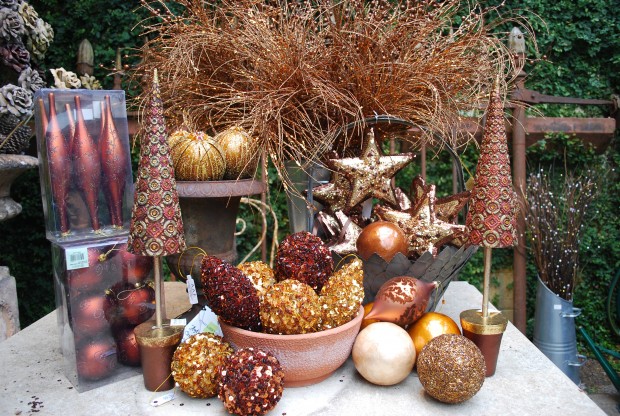
My first introduction to sparkle may have been a dress my Mom wore to a New Year’s Eve party at the Whitney in the 50’s. The fabric was woven from metallic thread in white gray and black. The dress was shimmery. At some point I would have seen a sequined ball gown, or black patent leather shoes. Sparkly fabrics and materials were reserved for formal evening events, when the daylight had vanished, and the party lights were dialed down low. Sparkly materials pick up and reflect whatever light there is available. Sparkling materials seem to glow or shine from within. In any event, all things sparkly, metallic, shimmery and glittery suggest celebration. Sparkle at this time of year is a pleasure to the eye.
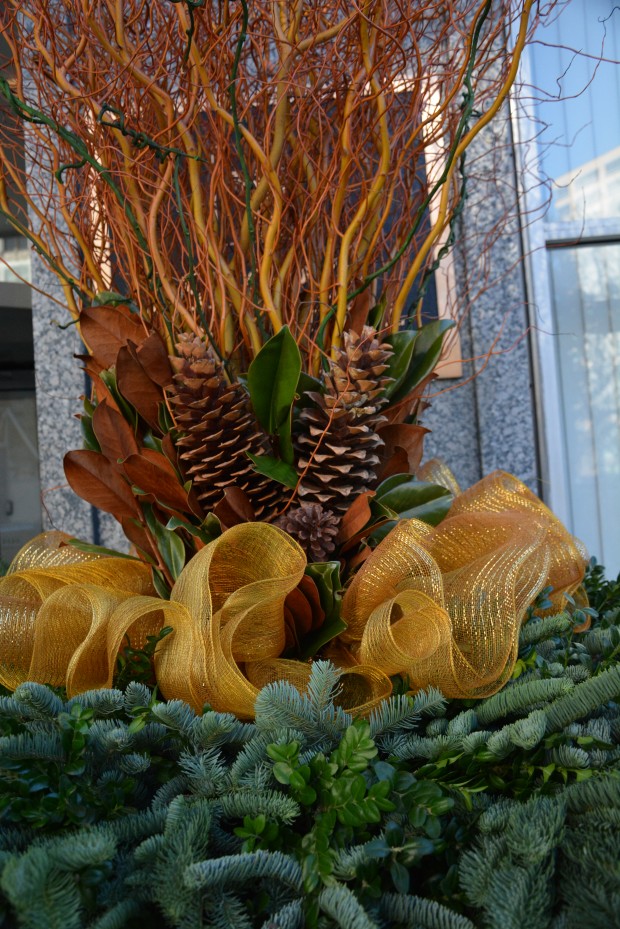 The transition from the fall to the winter season is marked the coming of the cold, and the dark. If I drive home from work at 5:30, it is dark. If I drive in to work at 7am, it is dark. November and December cold is bearable. But the dark can be daunting. Winter container arrangements and outdoor holiday decor that incorporates a little sparkle will read better in low light. This is a holiday season, meaning there is cause to celebrate. The copper curly willow, magnolia and boxwood in this arrangement have a glossy surface that reflects the light. The poly mesh fabric is shot through with a gold thread every so often. Arranging it in multiple curves and layers present lots of metallic surface area to the available light.
The transition from the fall to the winter season is marked the coming of the cold, and the dark. If I drive home from work at 5:30, it is dark. If I drive in to work at 7am, it is dark. November and December cold is bearable. But the dark can be daunting. Winter container arrangements and outdoor holiday decor that incorporates a little sparkle will read better in low light. This is a holiday season, meaning there is cause to celebrate. The copper curly willow, magnolia and boxwood in this arrangement have a glossy surface that reflects the light. The poly mesh fabric is shot through with a gold thread every so often. Arranging it in multiple curves and layers present lots of metallic surface area to the available light.
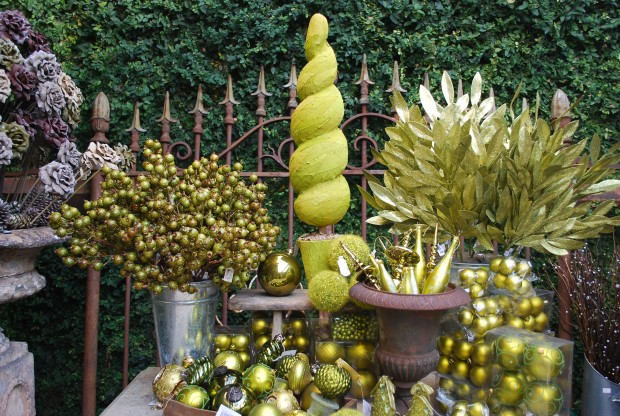 Most of the green in my garden is long gone, but for the evergreens. Needled evergreens present as little in the way of surface area to winter sun and winds-this helps them to conserve whatever moisture they have stored to survive the winter. I don’t expect or get sparkle from evergreen boughs, unless I have sprayed them with wilt pruf or vaporgard. These waxy antidessicants will impart some shine to your cut evergreens. Burt there are other ways to introduce a little sparkle. If you use artificial holiday picks in your outdoor containers, test them first. A dunk in a glass of water will tell you just about instantly whether the material is suitable for outdoor use.
Most of the green in my garden is long gone, but for the evergreens. Needled evergreens present as little in the way of surface area to winter sun and winds-this helps them to conserve whatever moisture they have stored to survive the winter. I don’t expect or get sparkle from evergreen boughs, unless I have sprayed them with wilt pruf or vaporgard. These waxy antidessicants will impart some shine to your cut evergreens. Burt there are other ways to introduce a little sparkle. If you use artificial holiday picks in your outdoor containers, test them first. A dunk in a glass of water will tell you just about instantly whether the material is suitable for outdoor use.
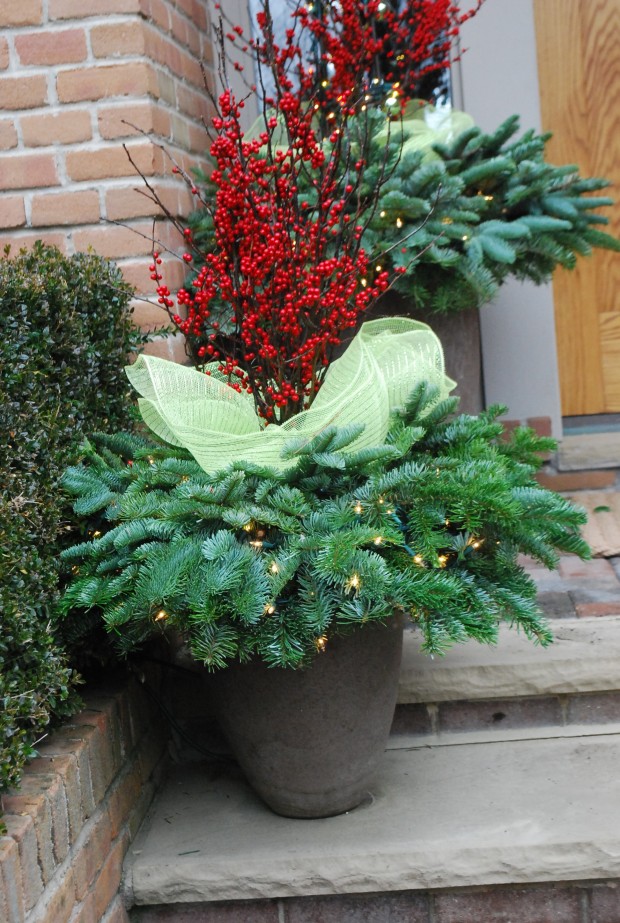 Poly mesh is not a natural material. It is just what the name says it is. It will have the same springy shape in March that it has now. Plenty of companies make plastic ornaments for outdoor use at the holidays, but glass ornaments are fine. We all have windshields, don’t we? If I use glass ornaments outdoors, I glue on and seal the caps. As long as you can keep water outside of the ornament, you should be fine. Natural Michigan holly is notorious for dropping its berries fairly quickly. A thorough soaking with vapor gard will add lots of gloss to that gorgeous red, and help prevent berry drop.
Poly mesh is not a natural material. It is just what the name says it is. It will have the same springy shape in March that it has now. Plenty of companies make plastic ornaments for outdoor use at the holidays, but glass ornaments are fine. We all have windshields, don’t we? If I use glass ornaments outdoors, I glue on and seal the caps. As long as you can keep water outside of the ornament, you should be fine. Natural Michigan holly is notorious for dropping its berries fairly quickly. A thorough soaking with vapor gard will add lots of gloss to that gorgeous red, and help prevent berry drop.
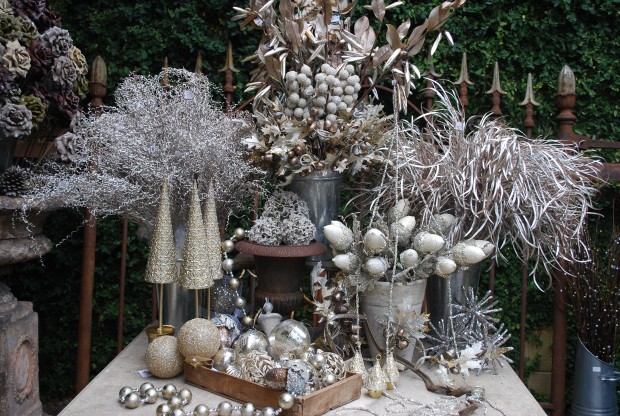 Sparkle comes in an incredible variety of textures. Glittered picks reflect lots of light. Plastic sprayed with a metallic coating glows. Ornaments coated in glass or plastic beads refract an incredible amount of light. Anodized aluminum wire comes in a wide variety of colors. Some paper wrapped metallic picks will survive the winter outdoors-as long as there is no rain. Only snow. Snow resistant is much different than water resistant. Should you have lots of rain in November and December, an acrylic sealer might help you out.
Sparkle comes in an incredible variety of textures. Glittered picks reflect lots of light. Plastic sprayed with a metallic coating glows. Ornaments coated in glass or plastic beads refract an incredible amount of light. Anodized aluminum wire comes in a wide variety of colors. Some paper wrapped metallic picks will survive the winter outdoors-as long as there is no rain. Only snow. Snow resistant is much different than water resistant. Should you have lots of rain in November and December, an acrylic sealer might help you out.
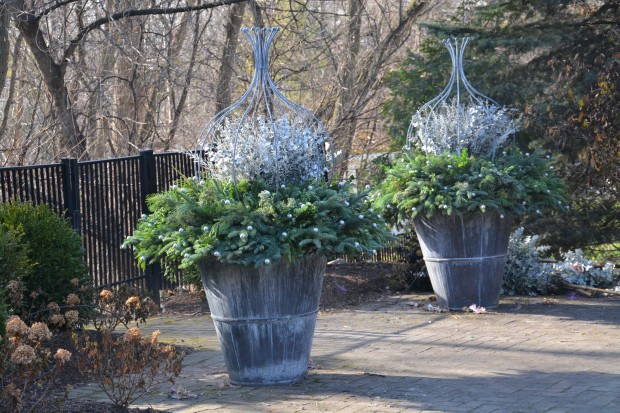 We did this pair of Branch tapers for holiday and winter today. The topiary forms were wound with lights after I took this picture. The big leaves of preserved silver eucalyptus reflect a lot of light. Lots of black picks with rhinestone dots will reflect the natural and artificial light. Lots of the frasier fir boughs have small shiny gray ornaments wired to the tips.
We did this pair of Branch tapers for holiday and winter today. The topiary forms were wound with lights after I took this picture. The big leaves of preserved silver eucalyptus reflect a lot of light. Lots of black picks with rhinestone dots will reflect the natural and artificial light. Lots of the frasier fir boughs have small shiny gray ornaments wired to the tips.
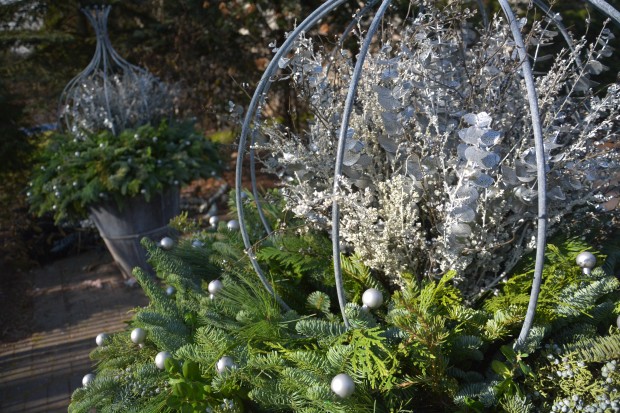 There are lots of opportunities for sparkle here. Located at the end of the driveway, these will transform and reflect the available winter light many times over.
There are lots of opportunities for sparkle here. Located at the end of the driveway, these will transform and reflect the available winter light many times over.
 This third pot is located under the under hang, and will never get much in the way of light. The silver glittered sticks in the center will make the most of whatever light is available. I have clients for whom natural materials are the materials of choice. Others like a little sparkle. The best part of decorating the garden is that so many materials are available, anyone can assemble a group of materials that perfectly expresses their own individual idea of the holiday.
This third pot is located under the under hang, and will never get much in the way of light. The silver glittered sticks in the center will make the most of whatever light is available. I have clients for whom natural materials are the materials of choice. Others like a little sparkle. The best part of decorating the garden is that so many materials are available, anyone can assemble a group of materials that perfectly expresses their own individual idea of the holiday.
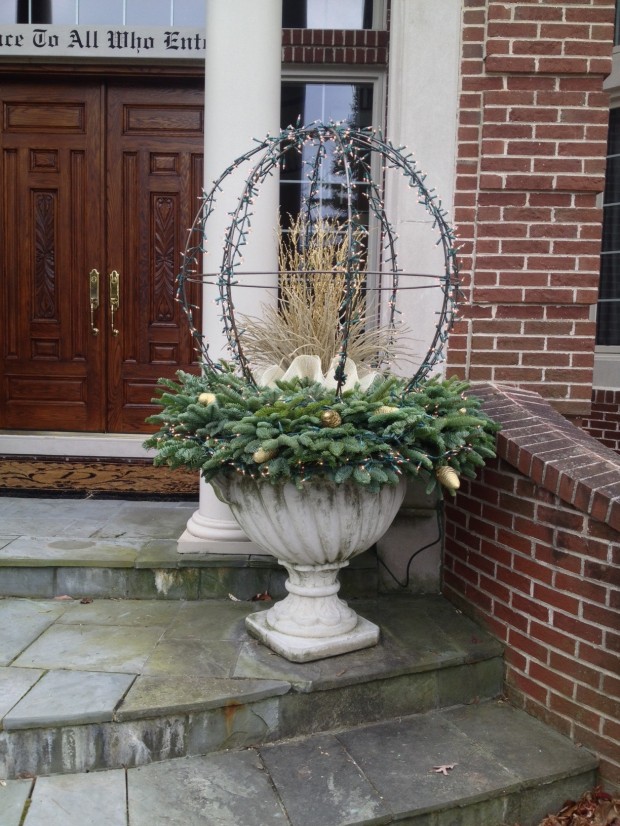 The pale gold metallic picks in several heights, the cream and gold sinamay, and the pale gold pine cones in this pot are rather subdued in this pot during the day. Come dark, the garland lights on the topiary form will create a whole lot of sparkle.
The pale gold metallic picks in several heights, the cream and gold sinamay, and the pale gold pine cones in this pot are rather subdued in this pot during the day. Come dark, the garland lights on the topiary form will create a whole lot of sparkle.
 Glass is a highly reflective material. There are enough shapes, sizes, and colors of glass ornaments to inform countless different holiday designs outdoors.
Glass is a highly reflective material. There are enough shapes, sizes, and colors of glass ornaments to inform countless different holiday designs outdoors.
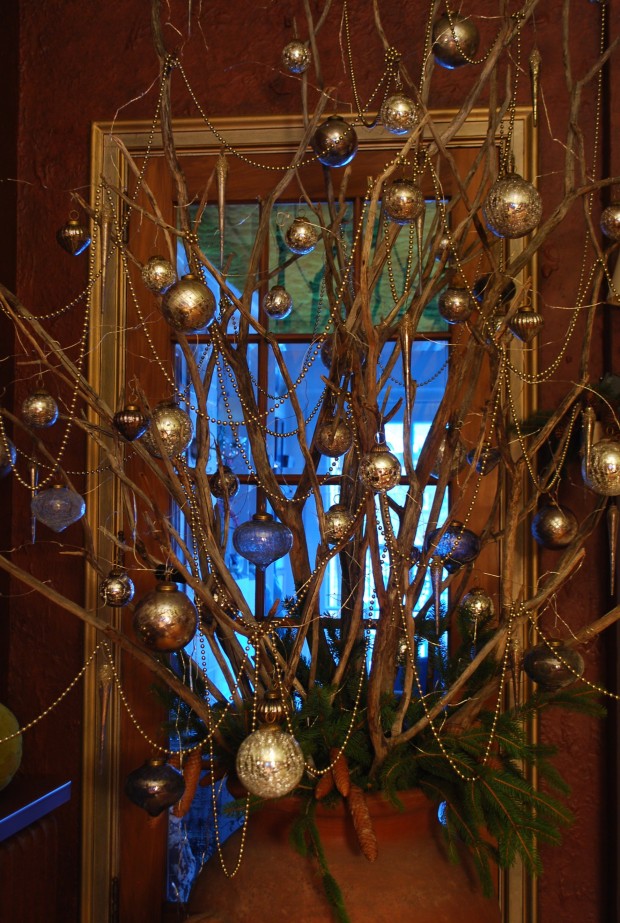 In a dark interior room, glass ornaments will gently shimmer. The plastic bead garlands pictured here come in a 30 foot length for 6.00. They can create a lot of holiday cheer, for not so much of an investment.
In a dark interior room, glass ornaments will gently shimmer. The plastic bead garlands pictured here come in a 30 foot length for 6.00. They can create a lot of holiday cheer, for not so much of an investment.
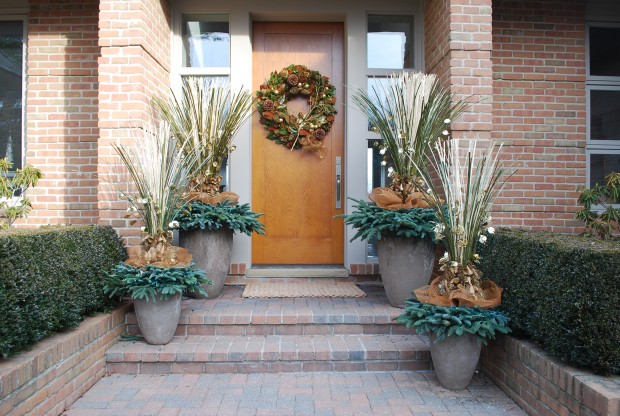 I have yet to see a landscape visually harmed by a little sparkle at the holidays. This is the time of year when a little celebration seems just right.
I have yet to see a landscape visually harmed by a little sparkle at the holidays. This is the time of year when a little celebration seems just right.
 My favorite part of this magnolia holiday wreath? The pale chocolate string ribbon-shimmering.
My favorite part of this magnolia holiday wreath? The pale chocolate string ribbon-shimmering.
